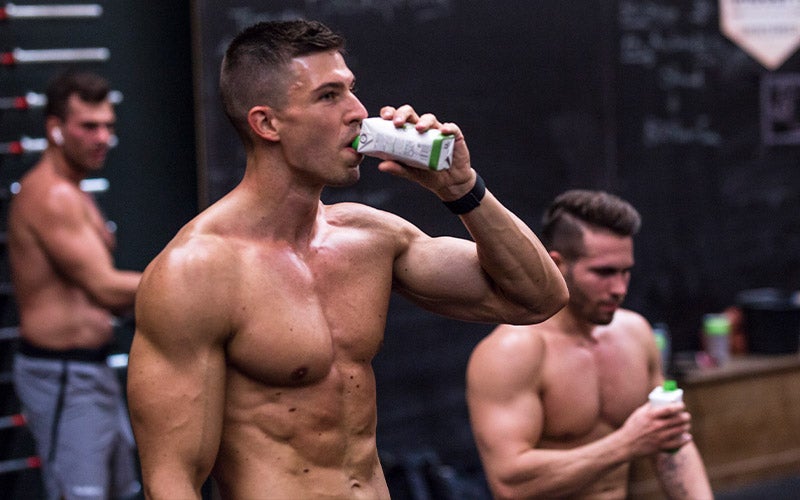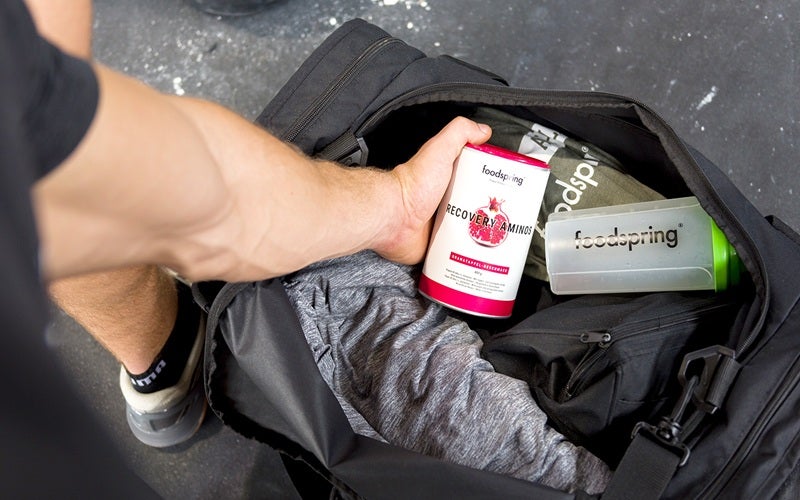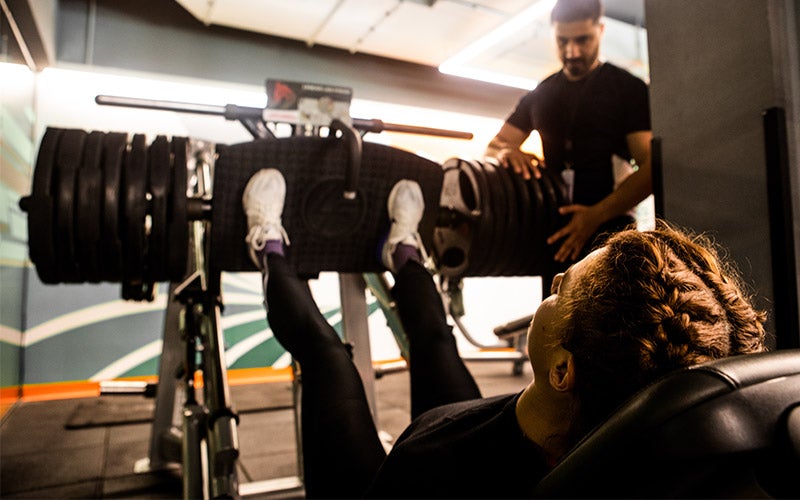How to Use Hypertrophy to Build Muscle
 ©foodspring
©foodspring
Muscular and powerful: Hypertrophy is the goal of most strength athletes. Hypertrophy muscle training promotes muscle growth by increasing the size of the muscle fibers – provided you train properly.
What is muscle hypertrophy?
Let’s start by laying a solid foundation—before we get down to the nitty-gritty, a definition: hypertrophy is generally understood to be an excessive size of tissues and organs due to the enlargement of cells, particularly due to heavy stress and strain.
You can think of hypertrophy as an increase in the thickness of individual muscle fibers; their cross-section increases without new muscle cells being formed by the body. This occurs only when the muscles are stressed beyond their normal performance level. In other words: while exercising, you should leave your comfort zone, although of course safe execution and technique still have priority.
Get started on your muscle-building journey with the Muscle Pack Basic Pro—complete with a 12-week guide to getting swole!

©foodspring
How does hypertrophy occur?
There are no gains without pushing yourself, and this is true for athletes who want to increase their strength in particular. In other words, your muscles must always be slightly overtaxed when exercising in order to increase their volume.
What really happens in the body after a set of squats or bicep curls? The overstrained muscle fatigues and small injuries to the muscle fibers, so-called micro-traumas, occur. But thankfully, our body is extremely proactive and efficient at using those micro-traumas to its advantage.
During the recovery phase after your workout, your muscles are repaired by the storage of new protein – the muscular building blocks.
The damage is not only repaired but the fibers are also strengthened so that the muscles are prepared for future demands of this kind. The body adapts, and the result is increased muscle size.
The decisive factor is that hypertrophy occurs during the periods of rest between workouts. Regeneration is, therefore, the most critical process here. Our Recovery Aminos with L-Glutamine and high-quality BCAAs support you in the best possible way and help you to go full throttle again next time.

How long does muscle growth take?
Through hypertrophy training, the body first learns to do more than it’s used to. In addition, the so-called intramuscular coordination, i.e. the interaction of the individual muscle fibers, improves. As this coordination improves, more and more parts of your biceps and triceps are active at the same time when you do, for example, a push-up.
As a result, the muscle’s cross-section increases. Of course, this doesn’t happen after just one workout. Depending on your physiology and athletic condition, it takes several weeks before your body masters techniques and movement patterns of an exercise and adapts. So be patient and don’t give up! Consistency is a crucial success factor in developing strength.
As soon as you’ve completed this “learning phase,” your desired muscle hypertrophy begins. After a few sessions of exercise such as resistance training, usually eight to twelve, you will eventually notice that you are making less progress and your growth is slowing down. Don’t worry, this is completely normal.
Once your muscles have become accustomed to a certain sequence, your body has no reason to adapt to it. You can now add weight to your resistance exercise, increase your number of repetitions, or vary the speed of the exercises to create new challenges. Updating your training plan will ensure variety and new achievements.

The main influencing factors of hypertrophy
The primary determiners for hypertrophy are your workouts and your diet.
In addition to challenging exercise and an appropriate protein and carbohydrate-rich diet, though, there are other factors that influence muscle growth:
Genetics: The composition of muscle fiber
There are two different types of muscle fiber, whose distribution in the body is genetically determined: The red ones (type I) are fatigue-resistant, meaning they work persistently but slowly. They are used, for example, in cardio and strength endurance training with higher repetition rates.
White muscle fibers (type II), on the other hand, are fast and strong. They are required to lift heavy weights or when you need to move quickly, such as for sprints or jumping exercises. Those who have more of these Type II fibers can build up muscle more easily through hypertrophy.
Endocrine balance
Several hormones are involved in developing muscles. Your hormonal balance depends on your age and sex, but also on your individual diet and lifestyle.
The male sex hormone testosterone has a strong anabolic, i.e. muscle mass building effect. Due to their higher testosterone levels, teenagers and men can build up larger muscles faster and more easily than women. Want to know how to increase your testosterone? We’ve got you covered.
Insulin is a metabolic enzyme that makes cell walls permeable to important macro- and micronutrients. These include essential amino acids that help you get the most out of your training.

Our tip: Our Energy Aminos are the ideal pre-workout drink to boost your muscle growth.
Insulin-like growth factor 1 (IGF-1) is an insulin-like hormone that promotes tissue growth in the body while suppressing muscle breakdown – a win-win situation for hypertrophy.
The stress hormone cortisol, unlike testosterone, is a catabolic, i.e. muscle-degrading hormone. It removes proteins from the muscles and converts them into glucose. The hormone that ensured our survival thousands of years ago is now inhibiting our muscle growth. So, try to keep your stress levels in check!
What is the difference between hypertrophy and hyperplasia?
Hypertrophy involves an increased cross-section of muscle fibers. They gain volume without forming new cells. Hyperplasia, on the other hand, refers to an increase in their number. This process is, however, controversial in muscle building.
Hyperplasia describes a process in the body in which organs and tissues increase in size through the multiplication of cells. In strength training, this may occur when hypertrophic muscles become too large to supply their cells with sufficient oxygen, causing cell division. This phenomenon has not yet been demonstrated in humans, though. When it comes to muscle growth, most health experts and researchers refer to hypertrophy.

What kind of exercise is optimal for building muscle?
If your goal is to increase your muscles’ hypertrophy limits, there is no way around a well-structured workout plan.
As a general rule, your plan should be based on the seven principles of load control: Train regularly and continuously. Your training load should be strenuous, and you should increase it at regular intervals. To do this, change your methods from time to time, integrate new exercises into your routine, and allow yourself enough breaks for recovery.
You can also use these three strategies to support muscular development: metabolic stress, mechanical tension and muscle injury.
You can combine all three in your exercise training or you can concentrate on one of them. It’s easier than you might think!
Metabolic stress
Have you ever been at the point where you just don’t have enough strength for one last pushup? Or feel your muscles still on fire after you’re done? That fatigue is a sign of metabolic stress.
The more repetitions and sets you do, the more your muscles swell. The blood vessels shrink and less oxygen reaches the muscle. As a result, the body produces metabolic byproducts such as lactic acid and creatine, which we perceive as a burning sensation. Fortunately, all this torment isn’t in vain, as the metabolic stress of protein synthesis has been proven to have a positive effect on muscle hypertrophy.
A practical tip: Train with a high number of repetitions (15-20 reps per exercise) at an intensity of 60 to 70 percent of your maximum strength.
Mechanical tension
Mechanical tension describes physical weight resistance. Holding a barbell or kettlebell requires you to apply some force, and your muscle must compensate and contract to maintain the weight.
A practical tip: We recommend low repetition rates (8-12 reps per exercise) at a higher intensity of 60 to 80 percent of your maximum strength. Increase the training volume each time, so that by the last set you only manage eight repetitions.

©Photographer, Basak Gurbuz Derman
Muscle injury
Damaging the muscle sounds unhealthy at first. But muscle injury is absolutely in our interest if we are trying to build muscle. If you lift heavy weights during a workout or if your muscles are under exertion for a long time, microscopically fine tears develop in the muscle fibers.
The good part: while you recover, the body repairs these tears and your muscles grow. The greater the injury, the longer this healing process takes (and the more uncomfortable it is to climb stairs the next morning!).
A practical tip: Train with heavy volume and low repetition rates (6-8 reps per exercise) at an intensity of 65 to 85 percent of your maximum strength. Also extend the eccentric phase, i.e. the speed at which the weights are released.
You will obtain the best results if you make use of the above techniques and integrate them into your training plan.
As soon as your body adapts, the increase in muscle will stagnate. You should adjust your activity plan every two to three months – for example, with new exercises, more volume and different patterns of sets, repetitions and breaks.
Summary
- Muscle hypertrophy is the growth in thickness of the muscle fiber, i.e. muscle growth.
- In order for it to occur, the muscles must be challenged beyond their usual performance level during training – e.g. by the intensity of the load, the number of repetitions, and the speed of the movements.
- A well-structured fitness plan and regular increases in performance are the key to developing strong muscles. Orientate yourself on the seven training principles.
- There are three mechanisms that athletes can use: metabolic stress, mechanical tension and muscle injury.
- Hypertrophy takes place during periods of rest. Sufficient recovery is vital if you want to build muscle.
- Athletes can support muscle hypertrophy by following a balanced diet rich in protein and carbohydrates, and by minimizing stress.
More healthy living tips from foodspring:
- 10 Foolproof Ways to Reach Your Goals
- Testosterone 101: Your Guide to Increasing Testosterone
- 10 Foods to Add to Your Diet if You Need More Vitamin D
- Get the Download on Essential Minerals
Sources for this article
We at foodspring use only high-quality sources, including peer-reviewed studies, to support the facts within our articles. Read our editorial policy to learn more about how we fact-check and keep our content accurate, reliable, and trustworthy.






















